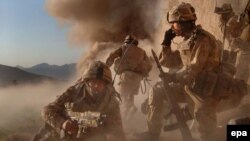Afghan President Hamid Karzai has accused "foreign interests" of being behind a Taliban offensive in Helmand Province, while other Afghan officials are specifically blaming Pakistan’s Inter-Services Intelligence (ISI).
In a statement issued by Karzai’s office after the Afghan president met with Pashtun tribal leaders from Helmand Province on June 26, Karzai said "foreigners were the motive" behind the Taliban offensive and "have been seen" fighting on the side of the Taliban.
Karzai called on Afghan Taliban "who consider themselves as children of Afghanistan to have mercy upon their own nation and stop fighting for foreign interests."
Karzai in the past has often used the term "foreign interests" to describe Pakistan without specifically naming the country.
Meanwhile, Helmand Province Governor Mohammad Naim told RFE/RL on June 26 that plainclothes members of the ISI and other Pakistani nationals have been seen fighting as part of Taliban units.
Naim said since the offensive was not organized by the Afghan Taliban, but rather, was "a major plan designed in Quetta [Pakistan]" by the Taliban's supporters and "frankly, the ISI."
When asked to elaborate on the source of information behind that claim, Naim’s spokesman Omar Zwak told RFE/RL that the reports came from Afghan intelligence officers who are in the battle zone and from many civilians who have fled the fighting.
Afghan Interior Ministry spokesman Najib Danish told RFE/RL most of the militants in the battle are "Pakistani military personnel or militia forces" who have donned the black turbans and black pants and shirt (shalwar kameez) typically worn by the Taliban.
Afghan officials on June 25 said more than 800 militants launched an offensive on June 20 along the northern arc of the Helmand River in a bid to retake territory recently vacated by U.S. troops and handed over to the control of Afghan government security forces.
More than 2,000 families have fled the fighting in the districts of Sangin, Nowzad, Kajaki, and Musa Qala.
Zwak told RFE/RL that fighting in the area was beginning to subside on June 26 and that government forces were beginning to regain control of areas seized by the militants since June 20.
That battle zone is notorious as one of Afghanistan's bloodiest areas of fighting for British and U.S. troops who have been deployed in Helmand Province since late 2001.
It encompasses valleys and agricultural land along the Helmand River and tributaries between the provincial capital, Lashkar Gah, and the strategic Kajaki Dam.
The area also is known as one of the biggest opium-producing areas that has funded the Taliban in Afghanistan.
The last U.S. Marines withdrew from the northern arc of the Helmand River in early May.
Security there is now the responsibility of four brigades in the 215th Afghan National Army Corps.
At a wartime peak during the 2010 U.S. military surge there were 21,000 U.S. Marines deployed in Helmand Province and other parts of southwestern Afghanistan.
About 4,500 U.S. Marines remain in Helmand, along with about 2,500 British troops, 800 Georgians, and smaller contingents of Estonians, Danes, and Jordanians.
rs/pmb







